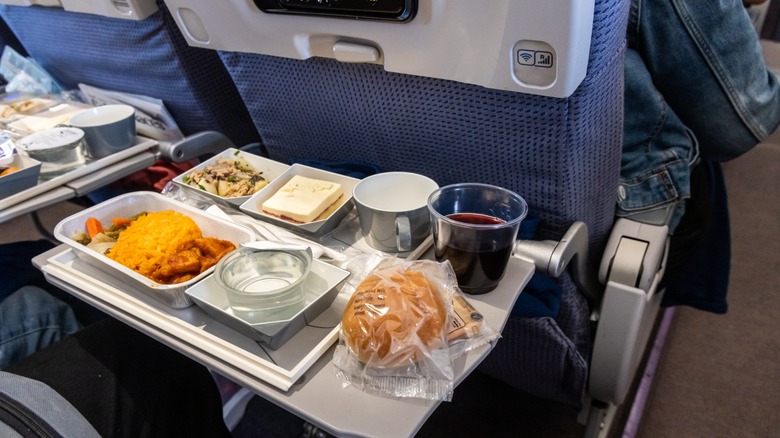The Type Of Food Gordon Ramsay Hates With An Absolute Passion
Gordon Ramsay, who previously schooled us on restaurant menu red flags, is never without a hilarious, foul-mouthed opinion on all things culinary, and that extends to airplane food. Ramsay actually has such a low opinion of the meals they serve on flights that he swears he would never touch them. "There's no f***ing way I eat on planes," he told Refinery29 in a 2017 interview. "I worked for airlines for ten years, so I know where this food's been and where it goes, and how long it took before it got on board."
Nor is Ramsay the only celebrity chef who eschews plane food. The late Anthony Bourdain, hater of American chicken meat, was always flying somewhere far-flung on his travel T.V. shows and was similarly dismissive. "No one has ever felt better after eating plane food [...] I don't eat on planes. I like to arrive hungry," he told Bon Appétit. Bourdain preferred to substitute airline meals for a bit of cheese and enough port wine to ensure he was feeling toasty until landing. As for Ramsay, his preference is to eat before he gets on the plane. "A nice selection of Italian meats, a little glass of red wine, some sliced apples or pears with some parmesan cheese," he opined ... which makes us wonder, does chef Ramsay know in which order to eat items on a charcuterie board? And is he correct about airline food being sus? That depends on who you ask.
The logistics of airplane food are meant to promote safety
While airline food mishaps make eye-catching headlines, such as the 2024 fiasco in which a long-haul Delta flight to Amsterdam served passengers expired food, on the whole, the food you eat on airplanes is subject to a host of carefully regulated protocols. These are meant to ensure that it's safe to consume, if not necessarily ragingly delicious. As part of that process, most major airlines have food prepared ahead of time in kitchens located close to the airport. The meals may be par-cooked so that they can finish in plane ovens or simply flash-chilled to be reheated, like a fancier T.V. dinner.
Unless you have booked a rare, uber-luxe passage like Turkish Airlines' candlelit dinner service, there likely is no chef preparing your meals fresh on board. This doesn't mean, however, that you are being served low-end fare. An average first-class meal costs the airline approximately $100 to serve. Of course, that's balanced out by the $4 in mundane snacks that economy passengers get served. And the simple fact is, unlike chef Ramsay, most people enjoy eating when flying. It kills time, quells nerves, and fills tummies that may be otherwise unsettled at 35,000 feet in the air. Famous chefs may turn their noses up at in-flight meals, but there's no reason that you have to.

